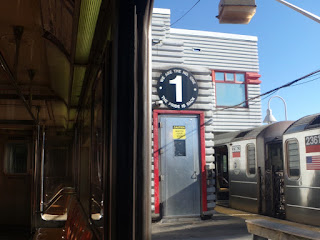I had lunch today in my favorite diner. There was a woman
patron a few tables behind me who was talking at-length about exterminating
rats and how problematic it was. It’s a small diner, by the way, and she was
loud—very loud. If I could hear her, so could everyone else in the place. I
thought: How could a person be so unmindful and inconsiderate to discuss doing
away with rats in an eatery? But, really, why should I have been surprised? We
live in an oblivious and insensitive time.
Yes, another year is just hours away from being consigned to
yesteryear. Another year, that is, in the Age of Unreason that we call
home. I typically avoid political subject matter—for obvious reasons—but after
reading the president-elect’s Happy New Year’s greeting, which referenced his
“many enemies,” the teeny-tiniest scrap of hope, which I tenaciously clung to,
vanished. I was hoping against hope, I guess, that the Orange Man—soon to be
the President of the United States—might not be as narcissistic and unhinged as
the previous mountain of evidence suggested. Hope doesn’t always spring
eternal. Rats!
Forty years ago when I was a youth, a “Russian Mission
Residency” opened its doors in the nearby neighborhood of Riverdale. Riverdale
in the Bronx was, and still is, upscale by the borough’s standards, and I
recall residents vehemently opposing the Commies coming to town. As memory
serves, the city gave Riverdale denizens something of an ultimatum: Accept the
Russians or get a public housing complex instead. It was whispered that the
community swallowed hard and opted for Red over Black.
We were in the midst of the Cold War back then, which now
seems—strangely—like the good old days. When contrasted with the garbled
present, it was a pretty cut-and-dried period. Taking sides was easy.
Fast-forward to the waning moments of 2016 and the president-elect, a
Republican no less, criticizes the sitting president for being too hard on
Russia, and tosses verbal bouquets to an autocratic thug. What a difference
four decades make. Ronald Reagan no doubt is spinning in his grave.
Funny, but there’s this fellow who grew up in my old
neighborhood. He—like countless others—has found a soapbox on Facebook. There
are legions of his kind who have been empowered on social media. You know: Men
and women whose ravings were—not too long ago in the scheme of things—confined
to the local drinking hole or the workplace water cooler. And, I might add,
it’s folks of all political persuasions who rave at the drop of a hat with a
keyboard at their disposal. But this particular guy recently opined on Facebook
that anybody who voted for Hillary Clinton was guilty of treason.
Treason…really? Now that’s painting with a pretty broad brush, I’d say, and a
rather harsh indictment of millions of people, including many of his hundreds
of “friends” on Facebook.
In waning hours of 2016, it seems to me that virtually everything is turned upside down and—alas—not likely to right itself in 2017. And it’s not merely the political landscape that’s bizarre and ugly. It’s everyone everywhere staring obsessively into their myriad devices—checking out Facebook, texting, and babbling on their cells. The world at large is unlikely, I fear, to become a better place in the new year and rats will still be a problem.
(Photo three from the personal collection of Nicholas Nigro)


















































